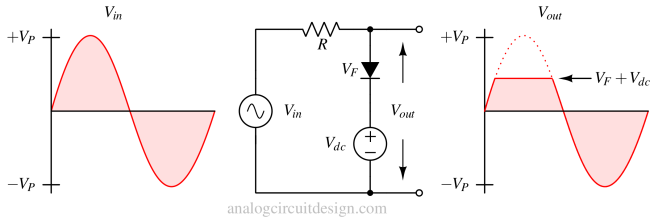Clipper vs Clamper circuits¶
Both Clippers and Clampers are diode-based wave-shaping circuits, but they serve entirely different purposes. While Clipper circuits "cuts" the signal, the Clamper circuit "shifts" it.
Clipper circuit¶
Clipper circuits limit the voltage below or above a certain DC voltage level. It clips/cuts the AC waveform above or below a certain DC threshold.
Applications¶
- Half wave rectifier is a clipper circuit since all voltages below zero at the input do not appear at the output.
- Over-voltage protection using a Zener diode ensures that delicate circuits at the output do not see a voltage above certain levels. It is also a clipper circuit.
Circuit implementation¶
The clipper circuit consists of a resistor and diode alone. Sometimes a level shifter (Vdc) is added to clip the waveform at the desired voltage level other than 0V. 
The above figure shows the operation of the clipper circuit. The diode is forward-biased and conducting when the Vin is more than VF + Vdc. When the diode is conducting, the output will be limited to VF + Vdc.
When Vin is less than VF + Vdc, the diode is non-conducting, and the output will be the same as Vin.
Know more about clipper circuits.
Clamper circuit¶
Clamper circuits provide DC shift without altering the AC waveform. The DC shift can be positive or negative.
Applications¶
- Many voltage doubler circuits.
- Class-AB bias circuits
- Level shifter circuits (e.g., voltage domain crossings)
Circuit implementation¶
The clamp circuit consists of a capacitor, and a diode. Sometimes, a DC level shifter (Vdc) is added to get a clamp voltage other than VP.

In the above figure, the positive peak is getting clamped to VF + VDC . The polarity of the diode and Vdc can be changed to make different types of clamper circuits.
Initially, at time t = 0, the capacitor is discharged. When the input crosses VF+VDC, the diode becomes forward biased and does not allow the output voltage to go beyond VF+VDC. The capacitor is getting charged to its maximum VP-(VF+VDC) voltage after the diode turn-on. When, Vin is falling from its positive peak, the \left plate of the capacitor is less than VP. A general rule of capacitor is the the voltage difference between the plates are retained unless discharged. To maintain the voltage difference, the \right plate comes below VP-(VP-VF-VDC) = VF + VDC. This turns-off the diode. So, there is no conduction of current, and the charge in the capacitor is preserved for the rest of the cycles. From now on, the capacitor will act as a battery with voltage ( VP-VF- VDC) and the output voltage will the shifted version of input voltage.
So, the output will be Vin-( VP-VF-VDC). Notice that there is a DC shift in the output, which is actually the function of a clamp.
Summary of difference between clipper and clamper circuits¶
- Clipper cuts the waveform while clamper level shifts the waveform.
- Clipper does not use a capacitor, while a basic clamper uses a capacitor to store the peak voltage. However, clamper circuits do not use a capacitor always like many class-AB bias circuits.
- Clipper circuits are called voltage limiters, while clamper circuits are called voltage multipliers.
- The output waveform of the clipper circuit may not resemble the input waveform however the clamper circuit's output waveform looks similar to the input waveform, except it is DC shifted.